|
|
 |
|
|
Playing Firestorm: Caen
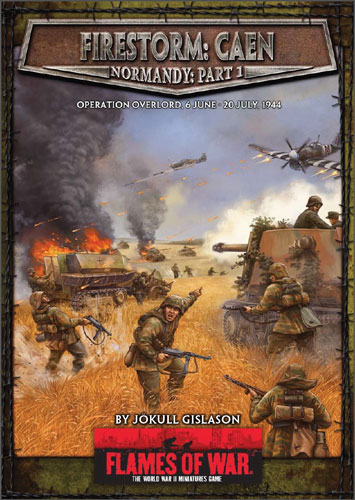 |
Playing Firestorm: Caen
A Walkthrough Of The Campaign
with Jökull Gislason
Welcome to a guide to Firestorm: Caen. This is a campaign that follows the exploits of the British and Canadian forces in Normandy from 6 June to 20 July 1944 and the ferocious defence put up by the Germans to prevent the city of Caen falling to the Allies. It is interesting to note that Monty's 2nd Army had advanced about 30 km/20 miles inland in about the same time as it had taken the Germans to defeat France, Belgium, Holland and the British Expeditionary Force in 1940. In 1944 the opposing armies were far more evenly matched in terms of experience and tactics.
|
Firestorm: Caen
Firestorm: Caen focuses on the British and Canadian landings on Gold,
Juno and Sword beaches right up to Operation Goodwood. It is a
full-sized campaign but has special rules for smaller groups or even a
two-player option. There are five turns in all, each named after the
major operations for each time period; Neptune, Perch, Epsom, Charnwood
and Goodwood. Covering the period between 6 June to 20 July 1944.
Download Firestorm: Caen here... |
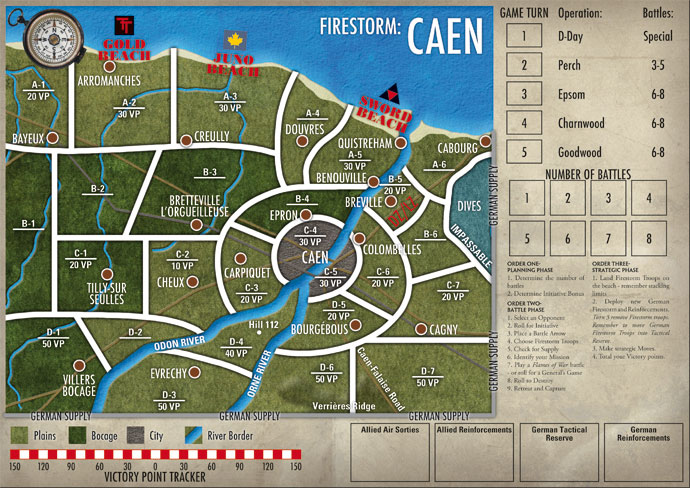 |
The Allies had
overwhelming superiority in forces but in the tight confines of Normandy
they had a hard time using that superiority and were finding it hard
going breaking out of the beachhead. Compounding the lack of battlefield
success was the issue of supply which still had to come ashore via the
beaches and the makeshift Mulberry harbour. The Germans of course had
their problems too; fighting a war on two fronts against the combined
military might of the Soviet Union, the United States of America and the
British and Commonwealth forces meant it was only a matter of time but
the men of the Wehrmacht would prove the still had plenty of fight in
them over the next few months.
|
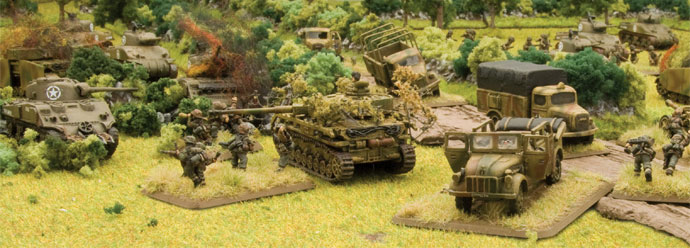 |
Firestorm: Caen is my third Firestorm campaign; it took about four months of my spare time to design. As with my previous campaigns; Firestorm: Greece and Firestorm: Lorraine I have tried to capture the essence of the campaign from both sides. With Firestorm: Caen extra time was taken to make certain of historical accuracy; ensuring all of the counters are named after their historical counterparts. This means that instead of silhouettes of units we use the NATO Military Symbols for Land Based Systems for some counters. For those with an interest in military history they should be recognisable enough.
|
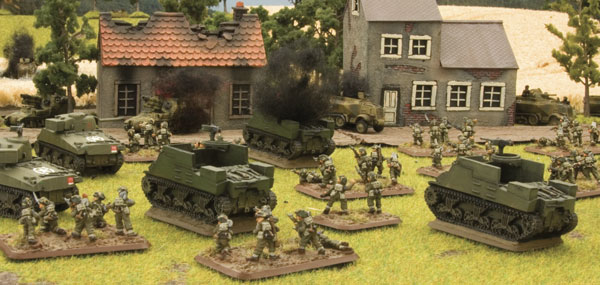 |
Firestorm: Caen proved a unique challenge
compared to the other Firestorms; mostly because it covers the day of
days, D-Day, at the start. The problem of how to manage the actual beach
landings was a tough nut to crack, but with some help from Stephen
Smith (Tinfish on the forums) we were able to get the ball rolling. From
there the pieces started to fall into place nicely. The campaign is
five turns and each turn is set in a certain timeframe and named after
the Allied operations at the time. |
The intention of this article is to demonstrate how to play the Firestorm: Caen and hopefully makes it easier for you as the reader to understand the mechanics of the game and then play it yourself. For my part I enjoy designing these and I really like playing campaigns, it makes each battle more enjoyable and adds an extra level of tension and excitement that one-off games often lack. I would however, encourage you to provide any feedback that you feel is appropriate. To me, nothing is more rewarding than hearing how the campaign has played out from other Flames Of War enthusiasts and further encourages me and the others involved to create more.
Firestorm: Caen can be played three ways; as a
full-campaign, as a mini-campaign or as the General's game. It is
designed to do any of these and even though a Flames Of War campaign is
more fulfilling I strongly recommend that you play a least a few
General's games first just to get the feel of how the campaign is going
to play out.
|
Playing it as a mini-campaign actually means combining a
Flames Of War and the General's Game; meaning that you select what
battles to play as actual games of Flames Of War and what battles you
roll of using the General's Game. This is an excellent option for small
groups or two players. As with all campaigns they require a little extra
effort but it is well worth it.
Setting Up The Game
Ideally
you should print the map and counters in colour; I recommend that you
use the A3 (B3 in America) but A4 (B4) will suffice.
|
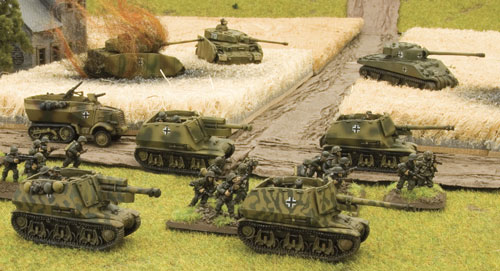 |
| The rulebook can be
printed in black and white, although it looks far better in colour even
if I do say so myself. I strongly recommend that you glue the map and
the counters to a piece of cardboard using a glue stick and then cut
them out. Sean Goodison, who you may be familiar with from the Flames Of
War Boot Camp videos, was the graphics designer on Firestorm: Caen and
did a great job with the counters, placing them close to each other to
save the amount of time spent on cutting them out. |
Below: The counters glued to a piece of cardboard and ready to be cut-out. I use a pencil (or a pen) and ruler and score the lines to make it easier to cut them out with a hobby knife.
|
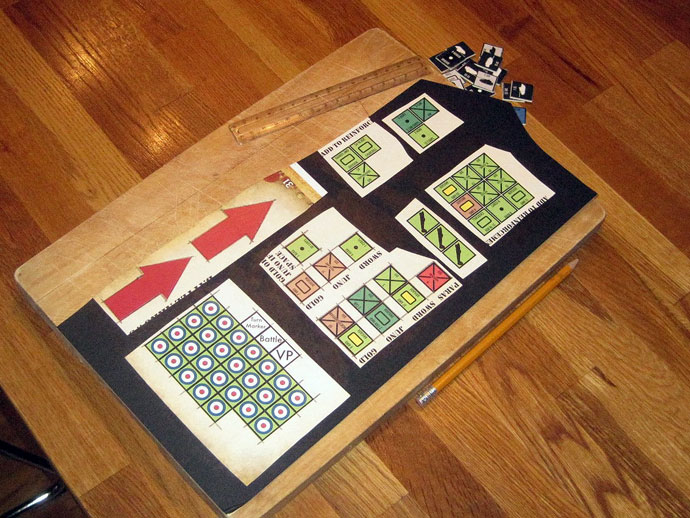 |
| I should also mention that the counters are actually colour-coded. See the tables below for more details. |
Allies
|
Counter Colour
|
Unit Represented |
Green
|
Regular Confident Trained troops.
|
Dark Green
|
Canadians (they have Special Rules in Flames Of War games).
|
Brown
|
Veteran troops; some are Reluctant and some are Confident.
|
Red
|
Paratroopers.
|
|
Tank units are different according to types and most of the Brigades have yellow to distinguish them from Divisions, but take care that Canadians and Churchill tanks are brigades even if they don't have yellow in the centre.
|
Germans
|
Counter Colour
|
Unit Represented |
Black
|
SS troops. |
Grey
|
Wehrmacht.
|
Dark Blue
|
Luffwaffe
|
Note: The Werfer Brigades should be Grey.
|
|
The Firestorm values are listed from page 20; this is a new feature. You will see a point value in the upper right corner of each Firestorm troop type. This gives you the option of adding points to your force rather than that specific unit. Note that the point value is slightly less than the actual worth of the unit; this is intentional. But it is useful if you do not have the actual platoon needed or simply prefer to have the extra points instead. Remember you get either the platoon or the point value; not both.
|
Below: Instead of taking the actual Firestorm units, you may take the option of adding extra points to your exciting force. They are valued slightly less than the Firestorm unit itself but maybe useful for many reasons, like if you do not have the Firestorm Troop platoon available.
|
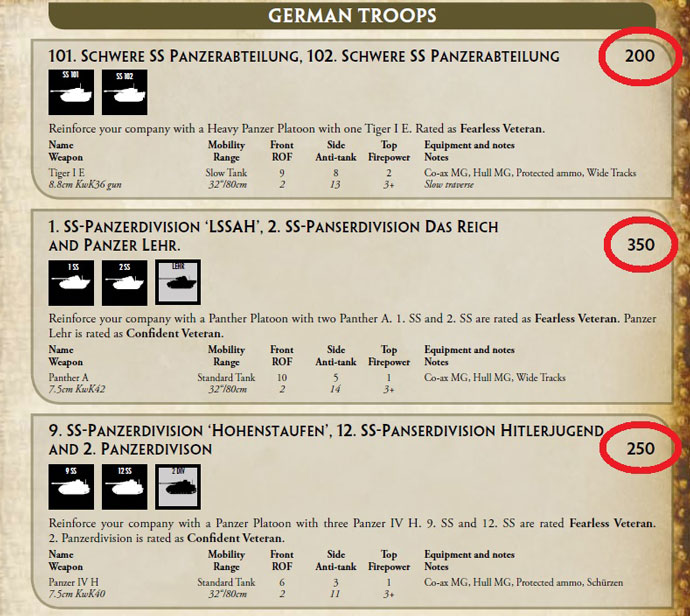 |
For the General's Game, each counter gives you a bonus listed on page 28. A forum member has asked about the German Defence Firestorm Troop listed as having a value of a D6 where 1-4 is +1 and 5-6 is +2 but the Variable Infantry Table (page 25) has the same result for 4 and 5. Well, this is intentional. Firestorm Troops are slightly different in General's Games and Flames Of War games so if you are playing a normal game then use the table on page 25 and for a General's Game use the bonuses listed on page 28.
Before starting the campaign ensure everyone agrees on what forces are going to be used. Will you allow only historical forces for that time and location? Or will you allow any Late-war army from any nation take part? Of course not every group will have the option of playing strictly historical forces but some will want to. The important thing is that everyone agrees before you start.
|
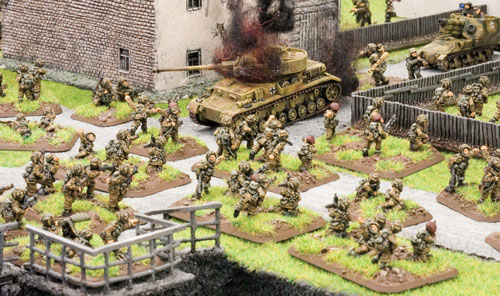 |
Turn One: D-Day
Turn one plays differently than any previous Firestorm. Here you will need a copy of Normandy Battles as the rules for D-Day invasions can be found there. The first turn is done step by step.
Step One: Operation Tonga
This is the landing of the 6th Airborne Division. That is best played using the Seize and Hold mission on page 19 in Normandy Battles.
|
This gives dedicated Airborne players chance to bring their Paras into
action. It is a risky operation and can result in the capture of the
Firestorm troops involved but the risk is worth it. For this mission,
use the 6th Airborne Firestorm troops in addition to your standard
forces. Compare the game outcome to the table on page 14. If you are
playing a General's Game the attacker just rolls one dice (without
modifiers) and compares the result to the table on page 14. This is very
risky, it is your choice how to play the game but actual games are more
likely to produce a less extreme result.
|
Step Two: Operation Neptune
Again use Normandy Battles if you are playing Flames Of War Games and again do not use the Firestorm Troops in this battle. Instead the Allies get additional units for every 1000 points or part there off. Pick one of the following for each 1000 points or part of; Naval Gunfire Support; Breaching Group; Commando Section or three Sherman DD tanks. Each option only be chosen once and this comes instead of the Overwhelming Force rule of page 28 of Normandy Battles.
|
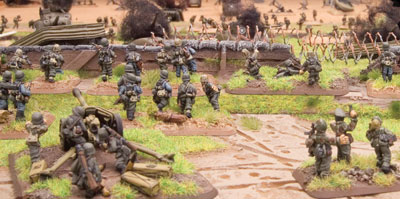
|
Compare the outcome to the table on page 15 in the campaign rulebook
rather. The beach landing always succeeds but if the Allies manage a 6-1
or 5-2 victory and may make one further attack from the beach this
turn.
As with the Airborne Drop in the General's Game the
Attacker simply rolls one dice (without modifiers) and compares the
result with the table on page 15. Once more, the outcome from an actual
game will more often than not produce an average result.
|
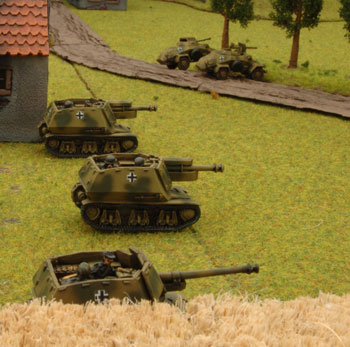 |
Step Three: Exploitation
If
any of the beach landings resulted in a stunning or major victory they
may now attack one area from those beaches. Note that for the first turn
the Axis does not get the German Defence Firestorm Troop but the Allies
may use their Firestorm Troops (depending on the Beach landing).
Step Four: Attack of the 21. Panzerdivison.
This is the only attack the Germans may make in the first turn. For this they get the 21. Panzerdivision as a Firestorm Troop and the Allies get any Firestorm Troops and Beach Naval Defence as appropriate if Sword Beach is attacked.
After the battles are concluded then you move to the Strategic Phase.
|
Step Five: Strategic Phase
First the Allied Player may land his reinforcements on the beach areas. Reinforcements are carefully listed on page 31. But here stacking comes into play. Both sides may only have three Firestorm Ground units in any one area at one time. This rule is new to Firestorm Games, but players familiar with other military board games should be familiar with stacking rules. When designing Firestorm Caen I found that stacking made the campaign run closer to the historical events. The Allies must expand their beachhead fast in order to make room for their reinforcements and bring their superiority in numbers into play. Note that any destroyed Allied Firestorm Troops must arrive on the beaches and are subject to the same stacking restrictions as others so the beaches can quickly become congested. The Axis receives reinforcements as well and places them anywhere on the map.
The German player should also check the following turn to see how many Firestorm Troops they can place into Tactical Reserve. The German Tactical Reserve is a key component of Firestorm Caen. From turn two, the Germans may keep one German Firestorm Troop in Tactical Reserve. Instead of placing this Firestorm Troop on the table place it in the appropriate box to the side of the map. Later in turn two (or later turns) the German player may place the Tactical Reserve Firestorm Troops into any battle in attack or defence as if they had been in the area attacked from or into. The Firestorm Troop takes part in the battle as normal except in a normal Flames of War Game it must start in Reserve, even in battles that do not normally have Reserves. In the General's Game it functions as normal. After the battle leave it where it is, it does not return to the Tactical Reserve.
Once reinforcements have been placed then starting with the Germans both sides make Strategic Moves and move up to three areas in friendly territory. From here on all standard rules are used.
|
Below: The German player can place a Firestorm Troop into Tactical Reserve in order to be called upon in attack or defence when required.
|
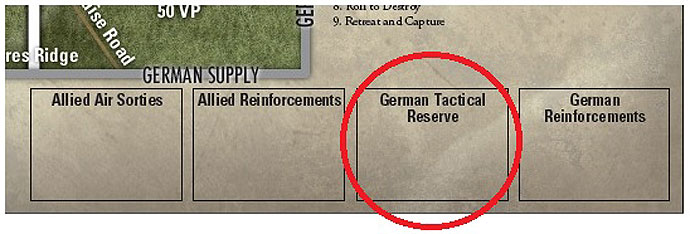 |
Turn Two: Operation Perch
All turns from this point vary in the number of battles; this is listed under the heading (page 16 of the Firestorm: Caen rulebook.). In this case, 1d3 + 2 giving you between three to five battles this turn.
|
Below: The board set up for the start of turn two. The Allies won a stunning Victory at Gold Beach and followed up attacking area B-3. A point of note is the Panzer Lehr unit held in German Tactical Reserve.
|
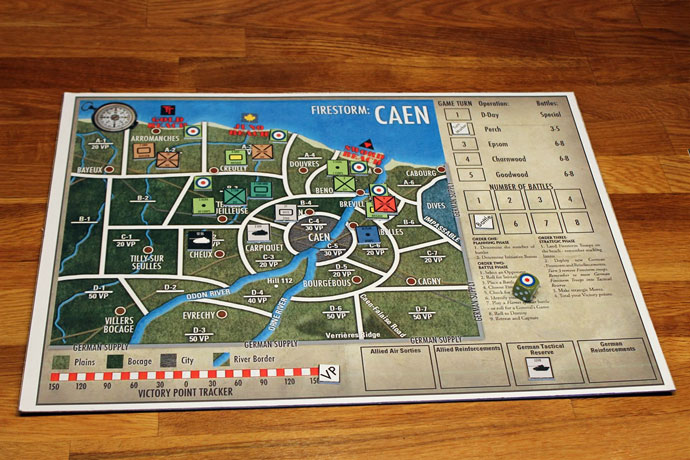 |
Now all the standard rules are in effect and the German Defence Firestorm Troops are active in defence of all areas. The German Defence Firestorm Troops do not have a counter but are considered to be present in all areas. They can only be used in defence and count as one Firestorm Troop. They give the Germans a variable unit in a normal game; see page 25 or a variable defensive value in the General's Game see page 28. The German Defence Firestorm Troop represents various German units all over Normandy that had to be fed into the battle piecemeal and could rarely concentrate their forces. These includes snipers, HMG nests, minefields, mortars, an under-strength Grenadier platoon with an anti-tank gun or StuGs and are very representative of the actual units that pestered the Allied invaders.
|
Air sorties for the Allies also come into play. Air support unlike standard Firestorm Troops never start deployed on the board, but can be added as a Firestorm Troop to any battle in attack or defence. The Allies have two sorties in turn two and from turn three onward they have three sorties they can call upon per turn.
The only special rule for turn three is the addition of a special attack at Villers-Bocage. If the Allies start in possession of or capture Bayeux (A-1) they capture B-1 and may attack with the 7th Armoured Division into Villers-Bocage (D-1).
|
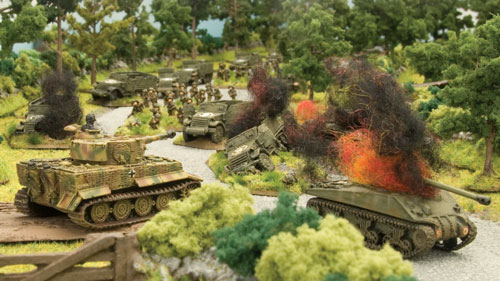 |
Once this happens the Germans get to place the
101. Schwere SS Panzerabteilung (or Wittmann if they want) then they
must battle for Villers-Bocage using the above Firestorm Troops but may
not add any further Firestorm Troops including Air Sorties or German
Tactical Reserves.
For a nice Battlereport on Villers-Bocage check out "Battle of Villers-Bocage! Finally!" by PanzerCDR on the forum here.
This special rule adds flavour and allows you to recreate a very famous part of the campaign. Remember that this special attack at Villers-Boage is in addition to the other 3-5 battles that are fought during this turn.
Finally, don’t forget to place two German units into tactical reserve for turn three and that the Allies must place their reinforcements subject to stacking restrictions on the beaches before they may make strategic moves.
|
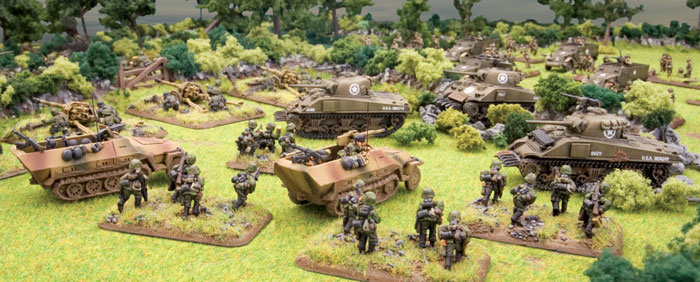 |
Turn Three: Operation Epsom
Turn three is the high water mark for the Germans. In this turn they will have eight Panzer Divisions and a SS Schwere Panzerabteilung to throw against the Allies. But the Allies will still have the lead in initiative. You may experience a lot of frustration as the attacker when the defenders throw one attack back after another. In Firestorm: Caen as in Firestorm: Lorraine and Firestorm: Greece only the attacker can capture new areas and the defenders only successfully defend if they win. This is an important dynamic as it will mean that the attacker will have to make calculated gambles with the odds in their opponents favour. Also note that there are area specific defence bonuses in the General's Game see page 28 of the Firestorm: Caen rulebook.
The most important rule in turn three comes into play at the end of the turn when the Germans are forced to withdraw three of their precious Firestorm Troops from play (historically they are off to fight the Americans). This will make the next two turns for the Germans even more difficult.
|
Below: A complete game set up for turn one.
|
Turns Four & Five: Operations Charnwood and Goodwood
Turns Four & Five: Operations Charnwood and Goodwood
These turns are fairly straight forward; the only new rule is that once per turn the Allies may call upon Capet Bombing. This can only be used in attack and is in addition to Firestorm Troops and works like a Preliminary Bombardment or a bonus in a General's Game and gives the Allies a better chance at breaking the Normandy stalemate.
At the end of turn five the Victory points are totalled and work out which side has won compared to the Campaign Outcome on page 12 on the Firestorm: Caen rulebook.
I hope you enjoy Firestorm: Caen. There was a lot of effort vested in its design and I would appreciate your feedback.
~ Jökull. |
Last Updated On Wednesday, July 10, 2013 by Blake at Battlefront
|
|
|